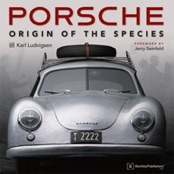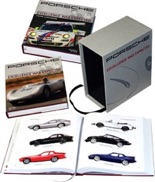Porsche - Origin of the Species


AUTHOR Ludvigsen
ENGLISH
ISBN 10 0837613310
ISBN 13 9780837613314
NO LONGER IN STOCK @ BLOCKS BOOKS
Carl Ludvigsen certainly has the lock on spectacular and spectacularly informative Porsche history book: first, in 1978, Excellence Was Expected, now out as a three volume edition 2.1 – unquestionably the best marquee history ever written, followed by Genesis of Genius, which took us from Professor Ferdinand Porsche’s early years up to more or less the beginning of World War 2. Still awaited is a middle volume to filling this gap. Instead, we have Porsche Origin of the Species; which rather than be a standard chronological series draws together a series of sequential and parallel events, without any one of which there would be no Porsche.
Porsche father and son had always raced and been willing to spend un-booked company time designing cars. Sometimes this worked out, as with the design for Typ 22 Grand Prix car, which was purchased by Auto Union. Sometimes the designs appeared to be still born, as with the Typ 64 and Typ 114. Typ 64? I had taken it as an article of faith that the Typ 64 was the Porsche-side design number corresponding to the VW 60 10K – remember Typ 60 was Porsche’s design number for the initial VW. Carl argues that the Typ 64 was not, even for the time, a particularly advanced design. Apparently Porsche developed the 60 10K as a purely VW effort – remembering of course that Porsche supplied the entire design and engineering staff to VW. The Typ 114 was the influential body design, on top of a VW-like pan. From there is not difficult to see the evolution; via the tube frame 356/1 and then the 356/2 bent sheet metal with attached aluminum body to the final monocoque.
On two levels the Cisitalia contract, which included several designs in addition to the nascent
Grand Prix car is just as important. First, is the well-known use of the Cisitalia payments to ransom/bail the Professor from his French prison. Not know to me at least is that the French government refunded the bail several years later. According to Piech, by the time the bail was returned, inflation was such that the funds were sufficient to buy several pair of shoes. Yet another necessary strand was the observation of the Cisitalia 202 – an expensive small sports car built from FIAT parts. This combined with the 60 10K was a necessary epiphany. Porsche would use VW parts to make a small but expensive sports car. Porsche also had a large, somewhat under employed, staff of around 150 in Gmünd; and Porsche was not loath to use them on an un-booked project. Perhaps most important: currency reform had come about and VW was paying royalties. Porsche had a money problem -- not too little but too much with its attendant tax liabilities. What better way to create a tax write-off than to build cars? There are perhaps half a dozen other threads woven into the story I haven’t mentioned. It’s not just the history, which is superb and has an amazing number of new facts, but the understanding of how they all interrelated and how they all had to happen and happen at the right time.
Finally we have the Mathé/Seinfeld Gmünd T 2222 ; Porsche 356/2-040, an Austrian Werkes engineering car until December of 1953, was purchased by Otto Mathé, who had previously purchased the Typ 60 10k in 1950. This is important since effectively Mathé was the car’s only owner until his death fifty years later. Not clear is whether the car’s rough condition is the way Porsche built it or patina acquired during Mathé’s ownership. On one hand Carl relates the first Gmünd 356/2s shown in Switzerland had to be tarted-up to make them presentable and I was told while in Sweden Scania Vabis had to do the same with the last of Gmünd models. On the other hand, Otto Mathé was not one to baby his cars – while apparently never raced Porsche 356/2-040 was used as a tow car for his open wheel race car, and to this day wears a Werkes built roof rack for carrying tires. Unlike other high profie car T 2222 was not subjected to a restoration, but sympathetically gone through to make it safe to drive and close to original – for instance the reconversion to left had drive had been improperly executed. Now we get to the beauty of the book. The hstorical photographs come from the factory – one can’t help wondering how many “previously unpublished” photographs still lurk in the Arkivs. The fly leaf and chapter heading photographs are beautifully shot by Michael Furman whle Klaus Schnitzler, Professor of Photography at Monclair State University, shot most of the contemporary photographs. Adding perspective and relating valued antidotes are Paul Russel on the restoration and Chuck Stoddard on the historical background and his own Gmünd coupe. And up front following Jerry Seinfeld’s introduction is 356 Registry member, enthusiast and top flight automotive designer Freeman Thomas with “The Legacy of Erwin Komenda.” I always learn something from Freeman– in this case the distinction between “floating” and connected shut lines.
As should be expected for $110.00, the reproduction and paper quality are superb. The book is large format – about a foot square, 343 pages. The only down side of a book this thick, is the tendency for its binding to separate – much like the original Excellence Was Expected – NEVER fold the covers flat, ALWAYS read on your lap or a Vee book stand.

